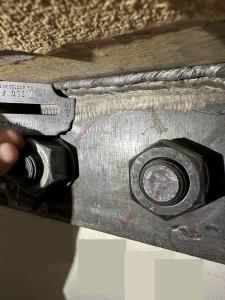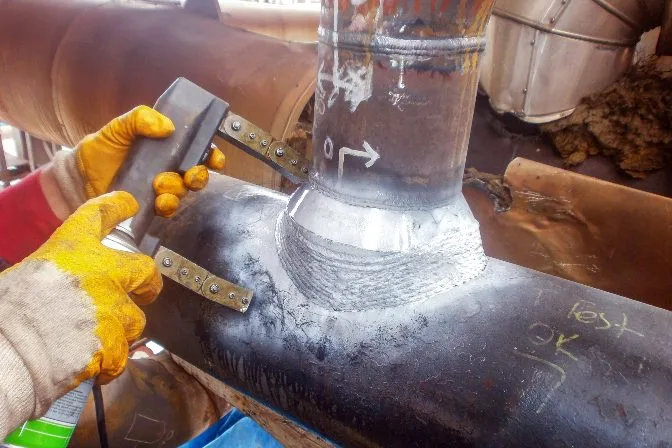How to Make Certain Quality with Welding Inspection Gilbert Arizona: Ideal Practices
A Comprehensive Overview to Welding Inspection: Comprehending Criteria, Techniques, and Ideal Practices for Quality Assurance
Welding examination plays a crucial function in guaranteeing the structural integrity and safety and security of bonded parts, requiring a detailed understanding of industry criteria such as those established by AWS and ASME. As we check out these important components, it comes to be noticeable that the effects of welding assessment prolong much beyond compliance, inviting a more detailed evaluation of just how these processes shape industry requirements and techniques.
Value of Welding Examination
Welding assessment plays an important function in ensuring the stability and security of bonded frameworks. It is an important procedure that confirms that welds adapt predefined specifications, which is crucial in numerous sectors, consisting of building and construction, automotive, and aerospace. By conducting extensive examinations, prospective defects such as splits, insufficient blend, and porosity can be identified early, avoiding disastrous failings that could lead to crashes or expensive fixings.
The value of welding examination expands past mere compliance with regulations; it additionally fosters depend on with stakeholders. Customers and regulative bodies expect guarantee that the structures they rely upon are constructed to endure functional anxieties. Furthermore, efficient welding evaluation methods add to long-lasting resilience and performance of the structures, ultimately leading to reduced maintenance costs.
Additionally, welding evaluation promotes a culture of high quality within companies, motivating adherence to ideal practices and continual improvement. By integrating examination procedures right into the welding process, companies can boost their reputation and develop themselves as leaders in quality control. To conclude, the importance of welding evaluation exists in its capability to guard lives, make sure architectural dependability, and support industry standards, making it an indispensable aspect of welding operations.
Key Sector Requirements
Making certain conformity with key market standards is essential for keeping the high quality and safety of welded frameworks. Numerous companies establish these requirements to promote ideal techniques in welding and evaluation - Welding Inspection Gilbert Arizona. Amongst the most identified are the American Welding Culture (AWS) and the American Society of Mechanical Engineers (ASME), which supply detailed guidelines and specifications for welding processes and inspection requirements
AWS requirements, such as AWS D1.1 for architectural welding, synopsis demands for materials, style, and testing to make sure the stability of welds. ASME codes, including ASME Section IX, govern the certification of welders and welding procedures, guaranteeing regular high quality in commercial applications. Worldwide, the ISO 3834 standard highlights top quality demands for combination welding, providing a framework for companies to show conformity with international ideal techniques.
Compliance with these criteria not just improves the dependability of welded structures however also minimizes dangers related to structural failings. Furthermore, adherence to sector criteria is frequently a prerequisite for regulatory approvals and can considerably influence job specs. Inevitably, understanding and applying these vital requirements are vital for reliable welding examination and quality guarantee.
Examination Techniques Introduction
Efficient welding inspection relies upon a variety of techniques created to evaluate the quality and stability of welds. These methods can be extensively categorized right into damaging and non-destructive screening (NDT) techniques. Non-destructive testing methods, which are extensively liked in the sector, allow for the evaluation of welds without compromising the honesty of the product.

Among one of the most generally used NDT strategies are aesthetic inspection, ultrasonic testing, radiographic testing, and magnetic bit testing. Visual assessment is usually the initial action in the examination procedure, allowing examiners to determine surface flaws and assess weld grain profiles. Ultrasonic screening utilizes high-frequency acoustic waves to identify internal flaws and measure the thickness of welds. Radiographic screening includes using X-ray or gamma-ray imaging to disclose interior flaws, while magnetic particle screening is effective for spotting surface and near-surface suspensions in ferromagnetic products.
Each method has its own advantages and constraints, making it vital for examiners to select one of the most proper technique based upon the certain requirements of the job, the products included, and the urgency of the welds being checked. This cautious option upholds and ensures comprehensive assessments security and high quality criteria in welding procedures.
Common Issues and Their Implications
A thorough understanding of common problems in welds is critical for keeping structural stability and safety and security in welded building and constructions. Welding issues can significantly compromise the mechanical buildings of the joint, bring about failures that might endanger both employees and devices.
Typical defects include porosity, which shows up as small gas pockets caught in the weld steel, compromising the overall structure. Breaking is an additional common concern, frequently arising from rapid cooling or incorrect joint style, causing anxiety concentrations that can lead to disastrous failures. Insufficient combination takes place when the weld metal stops working to appropriately bond with the base product, producing powerlessness that might result in separation under tons.
Other significant flaws include undercutting, where the weld bead erodes the base steel, and slag incorporations, which can prevent the weld's stamina. Each of these defects has details implications; for example, porosity can lower ductility, while cracking straight impacts tensile strength. Determining and comprehending these problems throughout evaluation is necessary for making certain and carrying out restorative measures conformity with market standards, ultimately protecting the structural honesty of welded settings up.
Best Practices for Top Quality Assurance
Implementing ideal practices for high quality assurance in welding procedures is vital for attaining optimum outcomes and decreasing problems. One crucial practice is the facility of clear welding procedures that adhere to industry standards see it here and specs. These procedures should consist view of in-depth instructions concerning material option, joint prep work, and welding methods to ensure uniformity and quality.
Routine training and qualification of welding workers are likewise crucial. Skilled welders that recognize the significance of quality assurance are most likely to create audio welds. Furthermore, applying a durable assessment program, including both aesthetic and non-destructive screening (NDT), can assist recognize flaws early in the procedure, permitting prompt corrective actions.

Lastly, cultivating a society of high quality within the organization motivates staff members to prioritize high quality in their work. By adhering to these best practices, organizations can enhance the integrity of their welding procedures, inevitably causing improved product quality and minimized prices associated with rework dig this and fixings.

Final Thought
In final thought, welding assessment plays a crucial function in making sure the stability and safety and security of bonded structures. By executing best techniques, companies can improve reliability, minimize upkeep expenses, and cultivate count on among clients, ultimately adding to successful welding operations.
Furthermore, welding inspection advertises a culture of high quality within organizations, urging adherence to best techniques and continual enhancement. In final thought, the relevance of welding examination exists in its ability to secure lives, ensure structural dependability, and copyright sector criteria, making it a vital aspect of welding procedures.
Among the most recognized are the American Welding Society (AWS) and the American Culture of Mechanical Designers (ASME), which supply detailed guidelines and specs for welding processes and assessment standards.
Eventually, understanding and executing these crucial standards are essential for effective welding inspection and high quality guarantee.
Efficient welding assessment relies on a range of methods made to assess the top quality and integrity of welds.